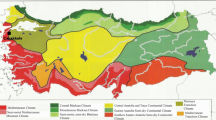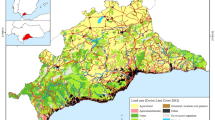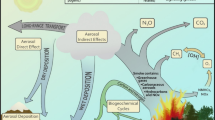Abstract
Forest fires means a potential threat to life on the planet since their effects can be catastrophic. Nowadays, the frequency of FF has increased, and the control capacity for it has decreased. The causes are diverse; however, the human factor is crucial in the generation, prevention, control, and mitigation of the impact of FF. This study presents the latest main FF events and the factors, causes, and variables involved in a general and global way. Additionally, has been carried out a study regarding the leading FF cases in Ecuador, it has been identified a sustained increase of burned hectares from 2015 to 2020, being 2020 the year with the highest incidence with 27,904.91 Ha. It has also been found that the increase or decrease of hectares burned depends on the fluctuations and relationships between wind speed, ambient temperature, humidity, and the characteristics of the geographic area where the events occur. It has also been identified that in the period 2018–2020 the Inter Andean region, presents most of the forest fires with a high level of damage.
Access this chapter
Tax calculation will be finalised at checkout
Purchases are for personal use only
Similar content being viewed by others
References
Ganteaume, A., Camia, A., Jappiot, M., San-Miguel-Ayanz, J., Long-Fournel, M., Lampin, C.: A review of the main driving factors of forest fire ignition over Europe. Environ. Manag. 51(3), 651–662 (2013). https://doi.org/10.1007/s00267-012-9961-z
World Wildlife Fund. https://www.wwf.org.ec/. Accessed 07 Nov 2020
Santoro, A., Venturi, M., Piras, F., Fiore, B., Corrieri, F., Agnoletti, M.: Forest area changes in cinque terre national park in the last 80 years. Consequences on landslides and forest fire risks. Land 10(3), 293 (2021)
The European Forest Fire Information System (EFFIS). https://effis-gwis-cms.s3-eu-west-1.amazonaws.com/effis/reports-and-publications/annual-fire-reports/2019_Fire_Report_HighRes_final_PTcorrection/Annual_Report_2019_final_topdf_2.pdf. Accessed 04 Feb 2021
Da Silva, A.S., Justino, F., Setzer, A.W., Avila-Diaz, A.: Vegetation fire activity and the Potential Fire Index (PFIv2) performance in the last two decades (2001–2016). Int. J. Climatol. 41, 78–92 (2021)
Global Forest Watch International Organization. https://www.globalforestwatch.org. Accessed 14 Feb 2021
Food and Agriculture Organization. http://www.fao.org/news/story/es/item/29145/icode. Accessed 14 Dec 2020
Cruz, H., Eckert, M., Meneses, J., Martínez, J.F.: Efficient forest fire detection index for application in unmanned aerial systems (UASs). Sensors 16(6), 893 (2016)
Cruz, H., Gualotuña, T., Pinillos, M., Marcillo, D., Jácome, S., Fonseca C., E.R.: Machine learning and color treatment for the forest fire and smoke detection systems and algorithms, a recent literature review. In: Botto-Tobar, M., Cruz, H., Díaz Cadena, A. (eds.) CIT 2020. AISC, vol. 1326, pp. 109–120. Springer, Cham (2021). https://doi.org/10.1007/978-3-030-68080-0_8
Fonseca C., E.R., Marcillo, D., Jácome-Guerrero, S.P., Gualotuña, T., Cruz, H.: Identifying technological alternatives focused on early alert or detection of forest fires: results derived from an empirical study. In: Botto-Tobar, M., Cruz, H., Díaz Cadena, A. (eds.) CIT 2020. AISC, vol. 1326, pp. 354–368. Springer, Cham (2021). https://doi.org/10.1007/978-3-030-68080-0_27
France vingt-quatre. https://www.france24.com. Accessed 24 Nov 2020
World Wildlife Found International Organization. https://www.worldwildlife.org/. Accessed 09 Jan 2021
World Health Organization. https://www.who.int/hac/techguidance/ems/vegetation_fires/es/. Accessed 14 Mar 2021
Besenyő, J.: Inferno terror: forest fires as the new form of terrorism. Terror. Polit. Violence 31(6), 1229–1241 (2019)
Zúñiga-Vásquez, J.M., Pompa-García, M.: The occurrence of forest fires in Mexico presents an altitudinal tendency: a geospatial analysis. Nat. Hazards 96(1), 213–224 (2018). https://doi.org/10.1007/s11069-018-3537-z
Muñoz-Robles, C., Santana-Arias, R.: Puntos de calor en la Sierra Madre Oriental de San Luis Potosí: patrones espaciales y factores asociados. Madera y bosques 24(1), 41–44 (2018)
Ruffault, J., Mouillot, F.: Contribution of human and biophysical factors to the spatial distribution of forest fire ignitions and large wildfires in a French Mediterranean region. Int. J. Wildland Fire 26, 498–508 (2017)
Xiong, Q., et al.: Fire from policy, human interventions, or biophysical factors? Temporal–spatial patterns of forest fire in southwestern China. For. Ecol. Manag. 474, 118381 (2020)
Lourenço, L., Fernandes, S., Nunes, A., Gonçalves, A.B., Vieira, A.: Determination of forest fire causes in Portugal (1966–2010) 4(3), 171–175 (2013)
Vacchiano, G., Foderi, C., Berretti, R., Marchi, E., Motta, R.: Modeling anthropogenic and natural fire ignitions in an inner-alpine valley. Nat. Hazards Earth Syst. Sci. 18(3), 935–948 (2018)
Lu, J., Zhou, T., Li, B., Wu, C.: Scale analysis and correlation study of wildfire and the meteorological factors that influence it. Math. Probl. Eng. 2018, 1–10 (2018)
Herndon, J.M., Whiteside, M.: Incendios Salvajes en California: el papel de la geoingeniería y de la manipulación atmosférica encubierta 17(3), 1–18 (2018)
Rasul, A., Ibrahim, G.R.F., Hameed, H.M., Tansey, K.: A trend of increasing burned areas in Iraq from 2001 to 2019. Environ. Dev. Sustain. 23(4), 5739–5755 (2020). https://doi.org/10.1007/s10668-020-00842-7
Parks, S.A., Dobrowski, S.Z., Panunto, M.H.: What drives low-severity fire in the southwestern USA? Forests 9(4), 165–169 (2018)
Sullivan, A.L.: Improving operational models of fire behaviour. In: Proceedings of the 18th World IMACS Congress and MODSIM 2009 International Congress on Modelling and Simulation. Modelling and Simulation Society of Australia and New Zealand and International Association for Mathematics and Computers in Simulation, pp. 2377–2383 (2009)
Sevinc, V., Kucuk, O., Goltas, M.: A Bayesian network model for prediction and analysis of possible forest fire causes. For. Ecol. Manag. 457, 117723 (2020)
Taufik, M., Veldhuizen, A.A., Wösten, J.H.M., van Lanen, H.A.J.: Exploration of the importance of physical properties of Indonesian peatlands to assess critical groundwater table depths, associated drought and fire hazard. Geoderma 347, 160–169 (2019)
Gannon, C.S., Steinberg, N.C.: A global assessment of wildfire potential under climate change utilizing Keetch-Byram drought index and land cover classifications. Environ. Res. Commun. 3(3), 035002, 1–15 (2021)
Dowdy, A.J., Mills, G.A., Finkele, K., de Groot, W.: Index sensitivity analysis applied to the Canadian forest fire weather index and the McArthur forest fire danger index. Meteorol. Appl. 17(3), 298–312 (2010)
Griffiths, D.: Improved formula for the drought factor in McArthur’s Forest Fire Danger Meter. Aust. For. 62(2), 202–206 (1999)
Heim, R., Jr.: A review of twentieth-century drought indices used in the United States. Bull. Am. Meteorol. Soc. 83(8), 1149–1166 (2002)
El Comercio. https://www.elcomercio.com/tendencias/incendios-forestales-fuego-casitagua-pichincha.html. Accessed 14 Jan 2020
Reporte Anual de la Secretaria Nacional de Gestión de Riesgos y Emergencias del Ecuador. https://www.gestionderiesgos.gob.ec/wp-content/uploads/2021/01/Informe-de-Situacion-No-031-Cierre-2020-Incendios-Forestales.pdf. Accessed 28 Mar 2021
Pazmiño, D.: Peligro de incendios forestales asociado a factores climáticos en Ecuador. FIGEMPA: Investigación y Desarrollo 1(1), 10–18 (2019)
Secretaria Nacional de Gestión de Riesgos y Emergencias del Ecuador. https://www.gestionderiesgos.gob.ec. Accessed 02 Feb 2021
Cedar Lake Ventures, Inc. https://es.weatherspark.com. Accessed 14 Jan 2021
Pausas, J.G.: Incendios forestales. Los Libros de la Catarata (2020)
Villers, L.: Incendios forestales. Ciencias 81, 234–244 (2006)
Abatzoglou, J.T., Williams, A.P.: Impact of anthropogenic climate change on wildfire across western US forests. Proc. Natl. Acad. Sci. 113(42), 11770–11775 (2016)
Peña-Fernández, E., Valenzuela-Palma, L.: Incremento de los incendios forestales en bosques naturales y plantaciones forestales en Chile. In: Memorias del segundo simposio internacional sobre políticas, planificación y economía de los programas de protección contra incendios forestales: Una visión global, pp. 595–612 (2008)
Acknowledgments
This work was partially supported by the PIS-04 “Detección temprana de incendios forestales basado en aprendizaje automático y en algoritmos de clasificación aplicados al espectro visible” research project of the Universidad de las Fuerzas Armadas ESPE, Ecuador and partially supported by the Work Group “Internet de las Cosas y Ciudades Inteligentes” of the Corporación Ecuatoriana para el Desarrollo de la Investigación y la Academia (CEDIA), Ecuador.
Author information
Authors and Affiliations
Corresponding author
Editor information
Editors and Affiliations
Rights and permissions
Copyright information
© 2022 The Author(s), under exclusive license to Springer Nature Switzerland AG
About this paper
Cite this paper
Cruz, H., Jácome, S., Gualotuña, T., Marcillo, D., Fonseca C., E.R. (2022). Causes and Variables of Forest Fires, a Brief Review of the Ecuadorian Case. In: Botto-Tobar, M., Cruz, H., Díaz Cadena, A., Durakovic, B. (eds) Emerging Research in Intelligent Systems. CIT 2021. Lecture Notes in Networks and Systems, vol 405. Springer, Cham. https://doi.org/10.1007/978-3-030-96043-8_31
Download citation
DOI: https://doi.org/10.1007/978-3-030-96043-8_31
Published:
Publisher Name: Springer, Cham
Print ISBN: 978-3-030-96042-1
Online ISBN: 978-3-030-96043-8
eBook Packages: Intelligent Technologies and RoboticsIntelligent Technologies and Robotics (R0)




